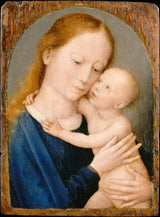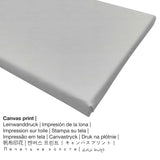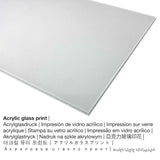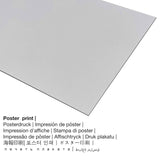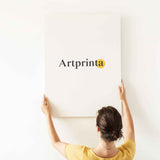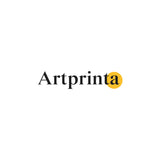Gerard David, 1490 - Nwa agbọghọ na-amaghị nwoke na nwa - mbipụta nka mara mma
Ụtụ gụnyere. Mbupu gbakọrọ na ndenye ọpụpụ.
Ngwaahịa nka mara mma nke onwe gị
na 1490 Gerard david created the northern renaissance masterpiece Amaghi nwoke na Nwa. The artwork measures the size: Overall: 6 1/8 x 4 1/2 in (15,6 x 11,4 cm); Painted Surface: 5 3/4 x 4 1/8 in (14,6 x 10,5 cm). Mmanụ na oak panel was used by the European artist as the medium of the work of art. It is included in the The Metropolitan Museum of Art's digital art collection - the museum is one of the world's largest and finest art museums, which includes more than two million works of art spanning five thousand years of world culture, from prehistory to the present and from every part of the globe.. We are pleased to state that this public domain piece of art is provided with courtesy of Ụlọ ihe ngosi nka nke Metropolitan, New York, mkpokọta Robert Lehman, 1975. Furthermore, the artwork has the creditline: Robert Lehman Collection, 1975. Besides, the alignment is in Eserese usoro na a akụkụ ruru nke 3: 4, nke pụtara na ogologo bụ 25% mkpụmkpụ karịa obosara. The artist, illuminator, painter, drawer, miniaturist Gerard David was a European artist from the Netherlands, whose style can primarily be classified as Northern Renaissance. The Dutch painter was born in the year 1460 in Oudewater, Utrecht province, Netherlands and died at the age of 63 n'afọ 1523.
Akụrụngwa ị nwere ike ịhọrọ
N'ime menu ndọpụta ngwaahịa ị nwere ike ịhọrọ nha na akụrụngwa nke gị. Nhọrọ ndị a dị maka n'otu n'otu:
- Mpempe akwụkwọ ederede (akwa akwa akwa): The poster print is a UV printed flat canvas paper with a slightly rough surface texture, which reminds the actual artwork. Please note, that depending on the absolute size of the poster print we add a white margin 2 - 6cm around the painting in order to facilitate the framing with a custom frame.
- Kwaaji: A printed canvas material applied on a wood frame. A canvas print of this artpiece will let you turn your own art print into a large size artwork. Canvas prints are relatively low in weight. That means, it is quite simple to hang your Canvas print without extra wall-mounts. That is why, canvas prints are suited for any kind of wall.
- Aluminom ihe eji eme ihe: This is a metal print manufactured on alu dibond with a true depth effect. A non-reflective surface make a contemporary impression. For the Aluminium Dibond print, we print the chosen artpiece onto the surface of the white-primed aluminum composite. The colors are vivid and luminous, the details of the print are very clear.
- Bipụta na enyo acrylic: An print on acrylic glass, often named a an art print on plexiglass, makes the original into décor. Your artwork will be made with modern UV print machines. This makes impressive, intense colors. Our acrylic glass protects your selected art replica against light and external influences for many more years.
Ozi dị mkpa: We try what we can in order to describe the art products as closely as we can and to exhibit them visually in our shop. However, the tone of the print products and the print result can vary to a certain extent from the image on your device's monitor. Depending on the settings of your screen and the quality of the surface, color pigments can unfortunately not be printed as exactly as the digital version depicted here. In view of the fact that the are printed and processed by hand, there may also be slight variations in the size and exact position of the motif.
Nkọwa ngwaahịa ahaziri ahazi
| Nkewa ngwaahịa: | nka nka |
| Usoro mmeputakwa: | mmeputakwa n'ụdị dijitalụ |
| Usoro mmepụta: | UV kpọmkwem obibi |
| Mmalite ngwaahịa: | emere na Germany |
| Ụdị ngwaahịa: | mmepụta ihe na-achọ |
| A na-atụ aro iji ngwaahịa eme ihe: | ime ụlọ, nka mgbidi |
| Nhazi nka nka: | nhazi ihe osise |
| Njikwa oyiyi: | 3: 4 ogologo ruo obosara |
| Pụtara nha akụkụ: | ogologo bụ 25% mkpụmkpụ karịa obosara |
| Ụdị ihe dị iche iche: | Mpempe akwụkwọ, akwụkwọ mmado (akwụkwọ kwaaji), mbipụta ọla (aluminium dibond), mbipụta iko acrylic (nwere ezigbo mkpuchi iko) |
| Canvas dị n'elu ihe nrịbama (mbipụta kanvas) nha dị iche iche: | 30x40cm - 12x16", 60x80cm - 24x31", 90x120cm - 35x47", 120x160cm - 47x63" |
| Mpempe iko acrylic (nwere ezigbo mkpuchi iko) nha dị iche iche: | 30x40cm - 12x16", 60x80cm - 24x31", 90x120cm - 35x47", 120x160cm - 47x63" |
| Ụdị akwụkwọ mmado (akwụkwọ kwaaji) dị iche iche: | 30x40cm - 12x16", 60x80cm - 24x31", 90x120cm - 35x47" |
| Mbipụta aluminom (ihe alumini debond ihe): | 30x40cm - 12x16", 60x80cm - 24x31", 90x120cm - 35x47" |
| Igwe onyonyo: | mmeputakwa na-enweghị isi |
Ozi ndabere ọrụ nka
| Aha nka: | "Vergin na Nwa" |
| Nhazi nka nka: | sere |
| Okwu mkpokọta: | nka ochie |
| Narị afọ nka: | 15th narị afọ |
| Afọ nka: | 1490 |
| Afọ nka: | 530 afọ |
| Usoro nka izizi: | mmanụ na oak panel |
| Nha nke ihe nka izizi: | Overall: 6 1/8 x 4 1/2 in (15,6 x 11,4 cm); Painted Surface: 5 3/4 x 4 1/8 in (14,6 x 10,5 cm) |
| Egosiputara na: | Museumlọ ihe ngosi nka nke Obodo |
| Ebe ngosi nka: | New York City, New York, Njikota Obodo Amerika |
| Webụsaịtị ihe ngosi nka: | Museumlọ ihe ngosi nka nke Obodo |
| License: | ngalaba ọha |
| Site n'aka: | Ụlọ ihe ngosi nka nke Metropolitan, New York, mkpokọta Robert Lehman, 1975 |
| Ebe E Si Nweta: | Nchịkọta Robert Lehman, 1975 |
Onye na-ese ihe
| Aha onye nka: | Gerard david |
| Aha ndi ozo: | Davidt Gheeraedt, Gerard David, David Gheeraert, Davidt Gheeraert, Davidt Gerard, David Gherat, Davidt Gherat, david gerard, gheeraert david, David, David Gheeraedt, Davit Gheeraert, Davit Gerard, Davit Gheeraedt, David Gerard, Davit Gherat |
| okike nke onye nka: | nwoke |
| Nationality: | Dutch |
| Ọrụ nke onye na-ese ihe: | drawer, artist, miniaturist, illuminator, painter |
| Mba onye si: | mba netherland |
| Nkewa onye nka: | nna ukwu ochie |
| Ụdị nke onye na-ese ihe: | Northern Renaissance |
| Oge ndu: | 63 afọ |
| Afọ ọmụmụ: | 1460 |
| Ebe omuma: | Oudewater, mpaghara Utrecht, Netherlands |
| Afọ nwụrụ: | 1523 |
| Obodo ọnwụ: | Bruges, West-Vlaanderen, Flanders, Belgium |
© Nwebiisinka nke - www.artprinta.com (Artprinta)
Original information about the artwork by The Metropolitan Museum of Art (© - The Metropolitan Museum of Art - Museumlọ ihe ngosi nka nke Obodo)
The infant Christ embraces his mother as the pair touch cheeks in an intimate expression of familial love. This panel may have been part of a devotional diptych, perhaps paired with an image of a donor figure or Christ Taking Leave of His Mother. Such a small picture would be easily transportable for devotional practice during travel. The painting was likely produced in the workshop of the Bruges-based artist Gerard David (ca. 1455-1523). In the early sixteenth century David tailored his creative output to meet the growing demands of the open market, creating series of images in a streamlined fashion with the participation of assistants and apprentices. It is in this context that the Virgin and Child belongs.

